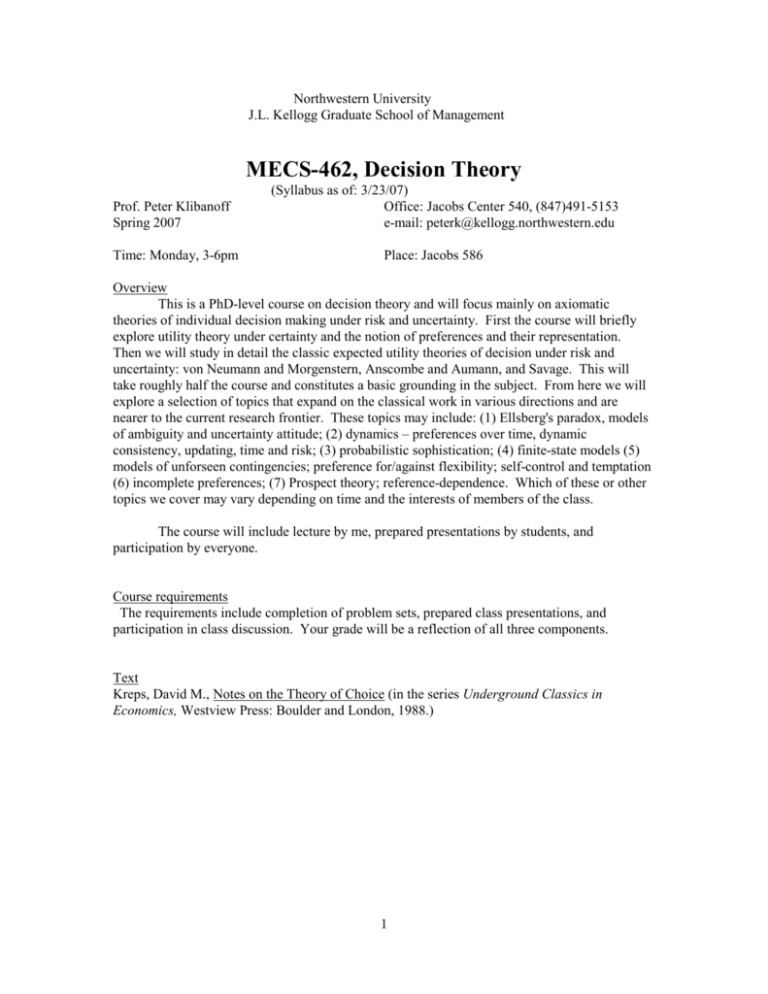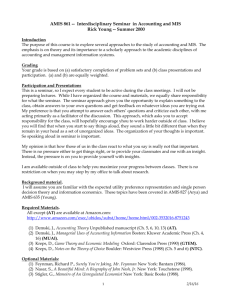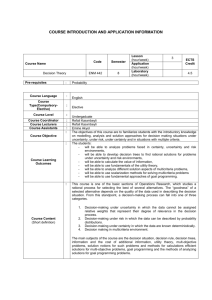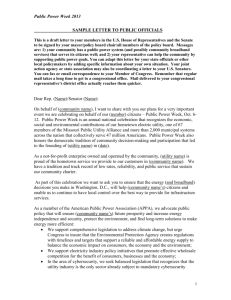Northwestern University - Kellogg School of Management
advertisement

Northwestern University J.L. Kellogg Graduate School of Management MECS-462, Decision Theory Prof. Peter Klibanoff Spring 2007 Time: Monday, 3-6pm (Syllabus as of: 3/23/07) Office: Jacobs Center 540, (847)491-5153 e-mail: peterk@kellogg.northwestern.edu Place: Jacobs 586 Overview This is a PhD-level course on decision theory and will focus mainly on axiomatic theories of individual decision making under risk and uncertainty. First the course will briefly explore utility theory under certainty and the notion of preferences and their representation. Then we will study in detail the classic expected utility theories of decision under risk and uncertainty: von Neumann and Morgenstern, Anscombe and Aumann, and Savage. This will take roughly half the course and constitutes a basic grounding in the subject. From here we will explore a selection of topics that expand on the classical work in various directions and are nearer to the current research frontier. These topics may include: (1) Ellsberg's paradox, models of ambiguity and uncertainty attitude; (2) dynamics – preferences over time, dynamic consistency, updating, time and risk; (3) probabilistic sophistication; (4) finite-state models (5) models of unforseen contingencies; preference for/against flexibility; self-control and temptation (6) incomplete preferences; (7) Prospect theory; reference-dependence. Which of these or other topics we cover may vary depending on time and the interests of members of the class. The course will include lecture by me, prepared presentations by students, and participation by everyone. Course requirements The requirements include completion of problem sets, prepared class presentations, and participation in class discussion. Your grade will be a reflection of all three components. Text Kreps, David M., Notes on the Theory of Choice (in the series Underground Classics in Economics, Westview Press: Boulder and London, 1988.) 1 Course Outline Week 1: Introduction; From choices to preferences; Preferences and ordinal utility Main Readings: Kreps, Chapters 1-3 Other Readings: Fishburn (1970), Chapters 2-3; Mas-Colell, Whinston, Green (MGW)(1995), Chapter 1. Problems: Kreps, Chapter 1, number 1; Chapter 3, numbers 2, 4, 5 and 6. (optional and requires more mathematical sophistication: Chapter 3, number 7) Week 2: Choice under risk -- von Neumann-Morgenstern expected utility Main Readings: Kreps, Chapter 4, pp. 31-33 and Chapter 5. Other Readings: Fishburn (1970), Chapters 8 and 10; MGW, Chapter 6.A-6.B. Problems: Kreps, Chapter 5, numbers 1 and 6. Also, prove axioms (5.1)-(5.3) are equivalent to axioms (5.1), (5.2), and (A4) (A4: there exists a countable -order dense subset of P). Note that for this last problem all axioms apply to preferences over P, the set of simple probability measures on a set X. Week 3: Attitudes towards risk; risk-aversion and utility Main Readings: Kreps, Chapter 6; Rabin (2000) Other Readings: Gollier (2001), Chapter 2; Ross (1981); Yaari (1969); Pratt (1964); MGW, Chapter 6.C. Problems: TBD Week 4: The lottery-acts approach to expected utility -- Anscombe-Aumann Main Readings: Kreps, Chapter 7 Other Readings: Sarin and Wakker (1997); Fishburn (1970), Chapter 13 Problems: TBD Week 5: A fully subjective approach to expected utility -- Savage Main Readings: Kreps, Chapters 8-9 Other Readings: Savage (1972, 1954), Chapters 1-5; Fishburn (1970), Chapter 14; Kopylov (2007) Problems: TBD 2 Week 6: Challenges to expected utility -- normative and descriptive; Responses: probability without expected utility Main Readings: Kreps, Chapter 12; Machina and Schmeidler (1992) Other Readings: Slovic and Tversky (1974); Kahneman, Slovic, and Tversky (1982); Machina (1987); Machina (1982); Allais (1953); Grant (1995); Dekel (1986); Machina and Schmeidler (1995); Chew and Sagi (2006) Problems: TBD Week 7: Responses: "expected" utility without probability; uncertainty/ambiguity attitude Main Readings: Schmeidler (1989); Gilboa and Schmeidler (1989); Klibanoff, Marinacci and Mukerji (2005) Other Readings: Epstein and Zhang (2001), Ghirardato and Marinacci (1999); Epstein (1999); Gilboa (1987); Nakamura (1990); Sarin and Wakker (1992); Camerer and Weber (1992); Chew and Karni (1994); Maccheroni, Marinacci and Rustichini (2006) Problems: TBD Weeks 8 and 9: Time – Preferences over consumption streams; risk and time; temporal lotteries; dynamic consistency; hyperbolic discounting Main Readings: Koopmans (1960); Epstein (1983); Kreps and Porteus (1978); Gul and Pesendorfer (2005); Karni and Schmeidler (1991a) Other Readings: Machina (1989); Epstein and Le Breton (1993); Hayashi (2003); Klibanoff and Ozdenoren (2007) Problems: TBD Week 10: Prospect Theory or Unforeseen contingencies/preference for flexibility/commitment or other topic of interest Main Readings: Kreps (1979) on preference for flexibility; Kahneman and Tversky (1979), Tversky and Kahneman (1992), and Tversky and Wakker (1993) on Prospect Theory Other Readings: Dekel, Lipman, Rustichini (1997, 2001); Kreps (1992); Nehring (1999); Gul and Pesendorfer (2001) 3 Some Readings and References Books Leonard J. Savage (1972), The Foundations of Statistics (2nd ed.), Dover, New York, 1972. First edition, 1954. Peter C. Fishburn (1970), Utility Theory for Decision Making, John Wiley and Sons, New York, 1970. Reprinted by Krieger Press, Huntington, New York, 1979. (Out of Print – I have a copy) Peter C. Fishburn, Non-linear Preferences and Utility Theory, 1988. Edi Karni, Decision Making under Uncertainty: The Case of State Dependent Preferences, Cambridge, MA.: Harvard University Press, 1985. D. Kahneman, P. Slovic, and A. Tversky (eds.) (1982), Judgment under uncertainty: Heuristics and biases, Cambridge University Press. D. Krantz, R. Luce, P. Suppes, and A. Tversky (1971), Foundations of Measurement, Volume I, Academic Press. A. Mas-Colell, M. Whinston, and J. Green (1995), Microeconomic Theory, Oxford University Press. Christian Gollier (2001), The Economics of Risk and Time, Cambridge, MA: MIT Press. Itzhak Gilboa (ed.) (2004), Uncertainty in Economic Theory: A collection of essays in honor of David Schmeidler’s 65th birthday, Routledge. Articles Allais, M. (1953), "Le Comportement de l'Homme Rationnel Devant le Risque: Critique des Postulats et Axiomes de l'Ecole Americane, " Econometrica, 21, 503-546. Anscombe, F.J. and R.J. Aumann (1963), "A Definition of Subjective Probability," Annals of Mathematical Statistics, 34, 199-205. Arrow, K.J. (1951), "Alternative Approaches to the Theory of Choice in Risk-taking Situations," Econometrica, 19, 404-437. Arrow, K.J. (1965), Aspects of the Theory of Risk Bearing (Yrjo Jahnsson Lectures), Helsinki: Yrjo Jahnssonin Saatio. Casadesus-Masanell, R., P. Klibanoff, and E. Ozdenoren (2000), "Maxmin Expected Utility over Savage acts with a Set of priors," Journal of Economic Theory, 92, 35-65. Casadesus-Masanell, R., P. Klibanoff, and E. Ozdenoren (2000), "Maxmin expected utility through statewise combinations," Economics Letters, 66, 49-54. Camerer, C. and M. Weber (1992), "Recent Developments in Modeling Preferences: Uncertainty and Ambiguity," Journal of Risk and Uncertainty 5, 325-370. Chew, S.H. and E. Karni (1994), "Choquet expected utility with a finite state space: commutativity and act-independence," Journal of Economic Theory, 62, 469-479. Chew, S.H. and J. Sagi (2006), “Event Exchangeability: Probabilistic Sophistication Without Continuity or Monotonicity,” Econometrica, 74, 771-786. de Finetti, B. (1937), "La Prevision: Se Lois Logiques se Sources Subjectives," Annals de L'Institute Henri Poincare, 7, 1-68. (Translated by H.E. Kyburg (1964), "Foresight, Its Logical Laws, Its Subjective Resources" in H.E. Kyburg and H. E. Sinkler, eds., Studies in Subjective Probabilities, New York: Wiley. Dekel, E. (1986), "An axiomatic characterization of preferences under uncertainty: weakening the independence axiom," Journal of Economic Theory, 40, 304-318. 4 Dekel, E., B. Lipman, A. Rustichini (1997), "Recent developments in Modeling unforseen contingencies," mimeo, (A shorter version appears in European Economic Review, May 1998). Dekel, E., B. Lipman, A. Rustichini (2001), "Representing Preferences with a Unique Subjective State Space," Econometrica, 69, 891-934. (Also see the 2005 corrigendum by T. Sarver together with DLR on Lipman’s BU web page.) Dow, J. and S. Werlang (1992), "Uncertainty Aversion, Risk Aversion, and the Optimal Choice of a Portfolio," Econometrica, 60, 197-204. Dow, J. and S. Werlang (1994), "Nash Equilibrium under Knightian Uncertainty: Breaking Down Backward Induction," Journal of Economic Theory 64, 305-324. Ellsberg, D. (1961), "Risk, Ambiguity, and the Savage Axioms," Quarterly Journal of Economics, 75, 643-669. Epstein, L. and M. Le Breton (1993), "Dynamically Consistent Beliefs must be Bayesian", Journal of Economic Theory, 61, 1-22. Epstein, L. and T. Wang (1994), "Intertemporal Asset Pricing Under Knightian Uncertainty," Econometrica 62, 283-322. Epstein, L. (1999), "A definition of uncertainty aversion," Review of Economic Studies, 66, 579-608. Epstein, L. (2000), "Are probabilities used in markets?" Journal of Economic Theory, 91, 86-90. Epstein, L. and J. Zhang (2001), "Subjective Probabilities on Subjectively Unambiguous Events," Econometrica, 69, 265-306. Ghirardato, P., P. Klibanoff and M. Marinacci (1998), "Additivity with multiple priors," Journal of Mathematical Economics, 30, 405-420. Ghirardato, P. and M. Marinacci (1999), "Ambiguity made precise: A comparative foundation," Social Science Working Paper 1026 (Revised), California Institute of Technology. Gilboa, I. (1987), "Expected Utility with Purely Subjective Nonadditive Probabilities," Journal of Mathematical Economics, 16, 65-88. Gilboa, I. and D. Schmeidler (1989), "Maxmin Expected Utility with Non-unique Prior," Journal of Mathematical Economics, 18, 141-153. Gilboa, I. and D. Schmeidler (1993), "Updating Ambiguous Beliefs," Journal of Economic Theory. Grant, S. (1995), "Subjective Probability without Monotonicity: Or How Machina's Mom May Also Be Probabilistically Sophisticated," Econometrica, 63, No. 1, 159-189. Gul, F. (1992), "Savage's theorem with a finite number of states," Journal of Economic Theory, 57, 99-110. Gul, F. and W. Pesendorfer (2001), “Temptation and Self-Control,” Econometrica, 69, 14031435. Gul, F. and W. Pesendorfer (2005), “The revealed preference theory of changing tastes,” Review of Economic Studies, 72, 429-448. Hayashi, T. (2003), “Quasi-stationary cardinal utility and present bias,” Journal of Economic Theory, 112, 343-352. Herstein, I. N. and J. Milnor (1953), "An Axiomatic Approach to Measurable Utility," Econometrica, 21, 291-297. Kahneman, D. and A. Tversky (1979), "Prospect Theory: An Analysis of Decision Under Risk," Econometrica, 47, 263-291. Karni, E. (1987), "Generalized Expected Utility Analysis of Risk Aversion with State-dependent Preferences," International Economic Review, 28, 229-240. Karni, E. and D. Schmeidler (1991a), "Atemporal dynamic consistency and expected utility theory," Journal of Economic Theory, 54, 401-408. 5 Karni, E. and D. Schmeidler (1991b), "Utility Theory with Uncertainty," Handbook of Mathematical Economics, Vol 4, W. Hildebrand and H. Sonnenschein, eds., North Holland, 1763-31. Klibanoff, P. (1996), "Uncertainty, Decision, and Normal-Form games," mimeo, Northwestern. Klibanoff, P. (2001), "Characterizing Uncertainty Aversion Through Preference for Mixtures", Social Choice and Welfare, 18, 289-302. Klibanoff, P. (2001), "Stochastically independent randomization and uncertainty aversion," Economic Theory, 18, 605-620. Klibanoff, P., M. Marinacci and S. Mukerji (2005), “A smooth model of decision making under ambiguity,” Econometrica, 73, 1849-1892. Klibanoff, P. and E. Ozdenoren (2007), “Subjective recursive expected utility,” Economic Theory, 30, 49-87. Kopylov, I. (2007), “Subjective Probabilities on ‘Small’ Domains,” Journal of Economic Theory, 113, 236-265. Kreps, D. and E. L. Porteus (1978), "Temporal Resolution of Uncertainty and Dynamic Choice Theory", Econometrica ,46, 185-200. Kreps, D. (1979), "A representation theorem for 'preference for flexibility'," Econometrica, 47, 565-577. Kreps, D. (1992), "Static choice in the presence of unforseen contingencies," in Economic Analysis of Markets and Games: Essays in Honor of Frank Hahn, P. Dasgupta, D. Gale, O. Hart, and E. Maskin (eds.), MIT Press, 259-281. Lo, K.C. (1996), "Equilibrium in Beliefs Under Uncertainty," Journal of Economic Theory. Maccheroni, F., M. Marinacci and A. Rustichini (2006), “Ambiguity Aversion, Robustness, and the Variational Representation of Perferences,” Econometrica, 74, 1447-1498. Machina, M.J. (1982), "'Expected Utility' Analysis Without the Independence Axiom," Econometrica, 50, 277-323. Machina, M.J. (1987), "Choice under uncertainty: Problems solved and unsolved," Journal of Economic Perspectives, 1, 121-154. Machina, M.J. (1989), "Dynamic Consistency and non-expected utility models of choice," Journal of Economic Literature, 27, 1622-1668. Machina, M.J. and D. Schmeidler (1992), "A More Robust Definition of Subjective Probability," Econometrica, 60, 745-780. Nakamura, Y. (1990), "Subjective expected utility with non-additive probabilities on finite state spaces," Journal of Economic Theory, 51, 346-366. Nehring, K. (1999), "Preference for flexibility in a Savage framework", Econometrica 67, 101119. Pratt, J. W. (1964), "Risk Aversion in the Small and in the Large," Econometrica, 32, 122-136. Pratt, J. W. (1988), "Aversion to one risk in the presence of others," Journal of Risk and Uncertainty, 1, 395-413. Rabin, M. (2000), "Risk Aversion and Expected-Utility Theory: A Calibration Theorem," Econometrica, 68, 1281-1292. Ross, S.A. (1981), "Some Stronger Measures of Risk Aversion in the Small and in the Large," Econometrica, 49, 621-638. Sarin, R. and P. Wakker (1992), "A Simple Axiomatization of Nonadditive Expected Utility," Econometrica 60, 1255-1272. Sarin, R. and P. Wakker (1994), "A General Result for Quantifying Beliefs," Econometrica, 62, 683-685. Sarin, R. and P. Wakker (1997), "A Single-Stage Approach to Anscombe and Aumann's Expected Utility," Review of Economic Studies, 64, 399-409. 6 Schmeidler, D. (1989), "Subjective Probability and Expected Utility Without Additivity," Econometrica, 57, 571-587. Skiadas, C. (1997), "Conditioning and Aggregation of Preferences," Econometrica, 65, No. 2, 347-367. Slovic, P. and A. Tversky (1974), "Who accepts Savage's Axiom?," Behavioral Science, 19, 368373. Stinchcombe, M. (1997), "Countably Additive Subjective Probabilities," Review of Economic Studies, 64, 125-146. Tversky, A. and D. Kahneman (1992), "Advances in Prospect Theory: Cumulative Representation of Uncertainty," Journal of Risk and Uncertainty, 5, pp. 297-323. Wakker, P. (1989), "Continuous subjective expected utility with non-additive probabilities," Journal of Mathematical Economics, 18, 1-27. Yaari, M. (1969), "Some remarks on measures of risk aversion and on their uses," Journal of Economic Theory, 1, 315-329. Reprinted in Diamond, P. and M. Rothschild (eds.) (1989), Uncertainty in Economics, Revised Edition, Academic Press. 7









